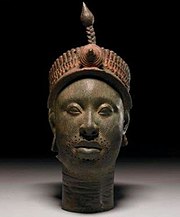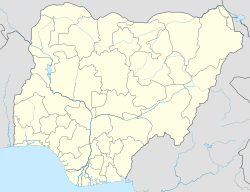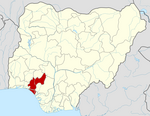Owo
Owo
Ọ̀ghọ̀ Ọ̀ghọ̀ Ìmàdẹ̀ | |
|---|---|
 A "Welcome to Owo" signpost | |
| Coordinates: 07°11′46″N 05°35′11″E / 7.19611°N 5.58639°E | |
| Country | Nigeria |
| State | Ondo State |
| Government | |
| • Olowo of Owo | Ajibade Gbadegesin Ogunoye III |
| Area | |
• Total | 383.7 sq mi (993.7 km2) |
| Elevation | 1,130 ft (344 m) |
| Population (2006) | |
• Total | 222,262 |
| Time zone | UTC+1 (WAT) |
| National Language | Yorùbá |
 | |
| Total population | |
|---|---|
| ~425,700 (2011) | |
| Regions with significant populations | |
| Ondo State - 425,700 · Owo Local Government: 258,230 · Ose Local Government: 167,470 | |
| Religion | |
| Christianity · Yoruba religion · Islam |
Owo is a local government area in Ondo state, Nigeria.[1][2] Between 1400 and 1600 CE, it was the capital of a Yoruba city-state.[3][4] The local government area has a population of 222,262 based on 2006 population census.[5]
History
[edit]| Part of a series on |
| Yorùbá people |
|---|
 |
In their oral tradition, Owo traces its origins back to the ancient city of Ile-Ife, the cradle of Yoruba culture.[6] Oral tradition also claims that the founders were the sons of the Yoruba deity Odudua, who was the first ruler of Ile-Ife. The early art-historical and archaeological records reinforce these strong affiliations with Ife culture.[6] Owo was able to maintain virtual independence from the neighboring kingdom of Benin, but was on occasion required to give tribute.[7] The transmission of courtly culture flowed in both directions between the Benin and the Owo kingdoms. The skill of Owo's ivory carvers was also appreciated at the court of Benin. During the seventeenth and eighteenth centuries, Benin's rulers increasingly utilized insignia made from ivory, and imported Owo's art objects and recruited its artisans for their own royal workshops.[8] There were other notable artworks that can be evidently supported.[9]
Owo came under British rule in 1893. After Nigeria declared independence in 1960, it was part of the Western Region until 1967 when it became part of the Western State. Owo and its indigenes played significant roles in the politics of the first Republic in Nigeria. In 1976, it became part of the newly created Ondo State.[4]
In June 2022, at least 50 worshippers were killed in a massacre at St. Francis Catholic Church.[10][11]
Culture
[edit]Owo has the largest palace (Aghofen) in Africa which was declared as a national monument by the federal government, and is also a cultural landmark in Nigeria[12] Built by Olowo Rerengejen in the 14th century, the palace had as many as 100 courtyards (Ugha). Each courtyard had a specific function and was dedicated to a particular deity. The largest, said to have been twice the size of an American football field, was used for public assemblies and festivals. Some courtyards were paved with quartz pebbles or broken pottery. Pillars supporting the veranda roofs were carved with statues of the king mounted on a horse or shown with his senior wife. The current Olowo is Ajibade Gbadegesin Ogunoye III.[13]
Economy
[edit]Owo is an agricultural center involved in the growing and trade of yams, cassava, maize, okra, peppers, cocoa, and cotton. There are, however, other commercial activities in the town including but not limited to timber, sawmilling and soya bean processing plants as well as blockmaking businesses.[4]
The town is dotted with branches of banks including First Bank Plc, Wema Bank Plc, Polaris Bank Plc, Enterprise Bank Ltd. (formerly Omega Bank Plc), Access Bank Plc etc. The city is witnessing a dramatic change due to expansion of its road network, particularly dualization of the main road beginning from the Emure junction up to Iyere exit. A new modern market is now open in Owo.[4]
Geography
[edit]Owo is situated in southwestern Nigeria, at the southern edge of the Yoruba Hills, and at the intersection of roads from Akure, Kabba, Benin City, and Siluko.[2] Owo is situated around the halfway point between the towns of Ile Ife and Benin City.[14]
Archaeology
[edit]The Owo site was first excavated in 1969–1971 by Ekpo Eyo under the auspices of the Department of Antiquities of the Government of Nigeria. Due to Owo's location between the two famous art centers of Ife and Benin, the site reflects both artistic traditions. Important discoveries include terracotta sculptures dating from the 15th century. The Owo Museum, founded in 1968, houses many of these artifacts.[4]
Climate in Owo
[edit]In Owo, the dry season is hot, muggy, and partly cloudy whereas the wet season is warm, oppressive, and overcast. The average annual temperature fluctuates between 65 °F (18.3 °C) and 89 °F (31.6 °C), rarely falling below 59 °F (15 °C) or rising above 94 °F (34.4 °C).
For hot-weather activities, favoring clear days with temperatures between 75 °F (24 °C) and 90 °F (32.2 °C), the "best" time to visit Owo is from somewhere around early November to mid-February.[15]
Traditional rulers
[edit]- Sir Olateru Olagbegi II (1941–1968 and 1993–1998). Dethroned in 1968 and reinstated in 1993.[16]
- Adekola Ogunoye II (February 1968 – November 1992)[17]
- Folagbade Olateru Olagbegi III (1999 – April 2019)[18]
- Oba Ajibade Gbadegesin Ogunoye III (since 12 July 2019)[19]
Gallery
[edit]-
Olowo of Owo in ceremonial attires during the Igogo festival.
-
Owo ivory artefact
-
Welcome to Owo signpost
-
Urban Water Kiosk, Oke Mapo, Owo
-
Roundabout Statue, Owo
-
St. John Unity Secondary school, Owo
-
Sir Olateru Olagbegi Civic Centre, Owo
See also
[edit]References
[edit]- ^ "Fig. 1a. Map of Nigeria showing Ondo State in relation Owo LGA Source:..." ResearchGate. Archived from the original on 2021-09-11. Retrieved 2021-09-11.
- ^ a b "Owo | Igbo-Yoruba, Ondo State, Benin-Nigeria | Britannica". www.britannica.com. Retrieved 2023-12-30.
- ^ "Tinubu mourns death of Olowo of Owo". Vanguard News. 2019-04-24. Archived from the original on 2021-09-11. Retrieved 2021-09-11.
- ^ a b c d e "AFRICA | 101 Last Tribes - Owo people". www.101lasttribes.com. Retrieved 2023-12-30.
- ^ Brinkhoff, Thomas. "OWO Local Government Area in Nigeria". City Population. Archived from the original on 9 March 2022. Retrieved 8 June 2022.
- ^ a b "Origins and Empire: The Benin, Owo, and Ijebu Kingdoms". metmuseum.org. Archived from the original on 12 November 2013. Retrieved 13 December 2013.
- ^ Smith (1988), Kingdoms of the Yoruba, p. 52.
- ^ "Exchange of Art and Ideas: The Benin, Owo, and Ijebu Kingdoms". metmuseum.org. Archived from the original on 12 November 2013. Retrieved 13 December 2013.
- ^ Willett, Frank; Picton, John (1967). "On the Identification of Individual Carvers: A Study of Ancestor Shrine Carvings from Owo, Nigeria". Man. 2 (1): 62–70. doi:10.2307/2798654. JSTOR 2798654. Archived from the original on 2016-03-07. Retrieved 2011-07-20.
- ^ Princewill, Nimi; Cassidy, Amy (2022-06-06). "Mass shooting at Nigeria church kills dozens, says local lawmaker". CNN. Archived from the original on 2022-06-06. Retrieved 2022-06-06.
- ^ "At least 50 killed in massacre at Catholic church in southwest Nigeria". Reuters. 2022-06-06. Archived from the original on 2022-06-05. Retrieved 2022-06-07.
- ^ "Inside Africa's largest palace". Tribune Online. 2018-03-27. Retrieved 2023-12-31.
- ^ Dada, Peter (2019-07-12). "Ajibade emerges new Olowo of Owo". Punch Newspapers. Retrieved 2023-12-30.
- ^ "Expedition Magazine | New Treasures From Nigeria". Expedition Magazine. Retrieved 2023-12-30.
- ^ "Owo Climate, Weather By Month, Average Temperature (Nigeria) - Weather Spark". weatherspark.com. Retrieved 2023-08-28.
- ^ "The life, times of Oba Olateru OlagbegiIi". Vanguard News. 2016-04-29. Archived from the original on 2022-04-08. Retrieved 2022-04-08.
- ^ "The Olagbegi/Ogunoye Tango and Its Misreading In History, By Femi Kehinde - Premium Times Opinion". 2019-09-29. Archived from the original on 2021-08-31. Retrieved 2022-04-08.
- ^ "BREAKING: Folagbade Olateru-Olagbegi, The 'Olowo Of Owo, Is Dead". Sahara Reporters. 2019-04-17. Archived from the original on 2021-05-05. Retrieved 2022-04-08.
- ^ "Olowo: How Ajibade Gbadegesin Ogunoye Emerged". PM Parrot. 13 July 2019. Archived from the original on 6 August 2020. Retrieved 18 April 2020.
Bibliography
[edit]- Smith, Robert Sydney (1988), Kingdoms of the Yoruba, (Madison: University of Wisconsin Press, 3rd ed.).
- Weisser, Gabriele (2008), Das Königtum der Owo-Yoruba: Zwischen Mythologie und Geschichte, (Hamburg, Kovac). (The kingdom of the Owo-Yoruba: Between Mythology and History).









